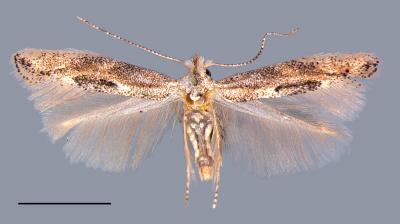The finding of an unknown small moth by Dutch amateur moth hunter Hans Huisman in his backyard lead to the discovery that the American Oak skeletonizer (Bucculatrix ainsliella) is invading North West Europe on planted Northern Red oaks (Quercus rubra), a North American tree.
"The finding is unusual", says Erik J van Nieukerken of Naturalis Biodiversity Center (Leiden, Netherlands), "because until recently few insects attacked this North American tree outside its natural habitat." He and co-authors just published a paper on this species in the journal Nota Lepidopterologica, a specialist journal for the study of moths and butterflies (Lepidoptera) in Europe.
Northern Red oaks are widely planted in Europe since the introduction in the 17th century, and the tree is important as a timber tree. Only one North American aphid, specialising on this kind of oaks has previously crossed the ocean. "The Red oaks are too different from European oaks to attract many of the specialist insects that feed on those," says Van Nieukerken, "and we usually only see insects that are common on many tree species." The identity was also shown by DNA barcodes showing no difference between European and American populations.

This is an adult American oak skeletonizer moth (Bucculatrix ainsliella).
(Photo Credit: Erik van Nieukerken, Naturalis Biodiversity Center)
Bucculatrix ainsliella is now common in most of the Netherlands, the northern part of Belgium and adjacent parts of Germany. The researchers expect it to be already more widely spread, and it will possibly invade most of Europe the coming years. Despite its abundant occurrence, it has nowhere lead to any visual damage, although it is known to be a pest occasionally in North America.
After the discovery was announced online and in the Dutch media in 2011, it turned out that many moth photographers and collectors in the Netherlands and Belgium had seen or collected the moth before, but were unable to identify it correctly. The earliest specimens of Bucculatrix ainsliella were found in the Netherlands as early as 1989, as was shown by overlooked specimens in the collection of Naturalis Biodiversity Center in Leiden. They were found in Amersfoort, a city close to a former NATO air base. It is very well possible that the small cocoons (with pupae) of the species, attached to any object, were transported by air. The emerging moths could immediately find their favourite food in the many Red Oaks that are planted in the Netherlands close to the airbase.
The larva of the newly discovered moth makes small leafmines in the oak leaves and later starts feeding on the leaf underside, eating the green tissue and leaving the veins intact. The effect of this feeding lead to the English name "Oak Skeletonizer". The caterpillar later makes a beautiful white ribbed cocoon that it fastens on leaves, trunks or any other item in its way. The small moth (wingspan 8 to 9 mm) can be found from April to October, and is attracted to light during the night.
Source: Naturalis Biodiversity Center